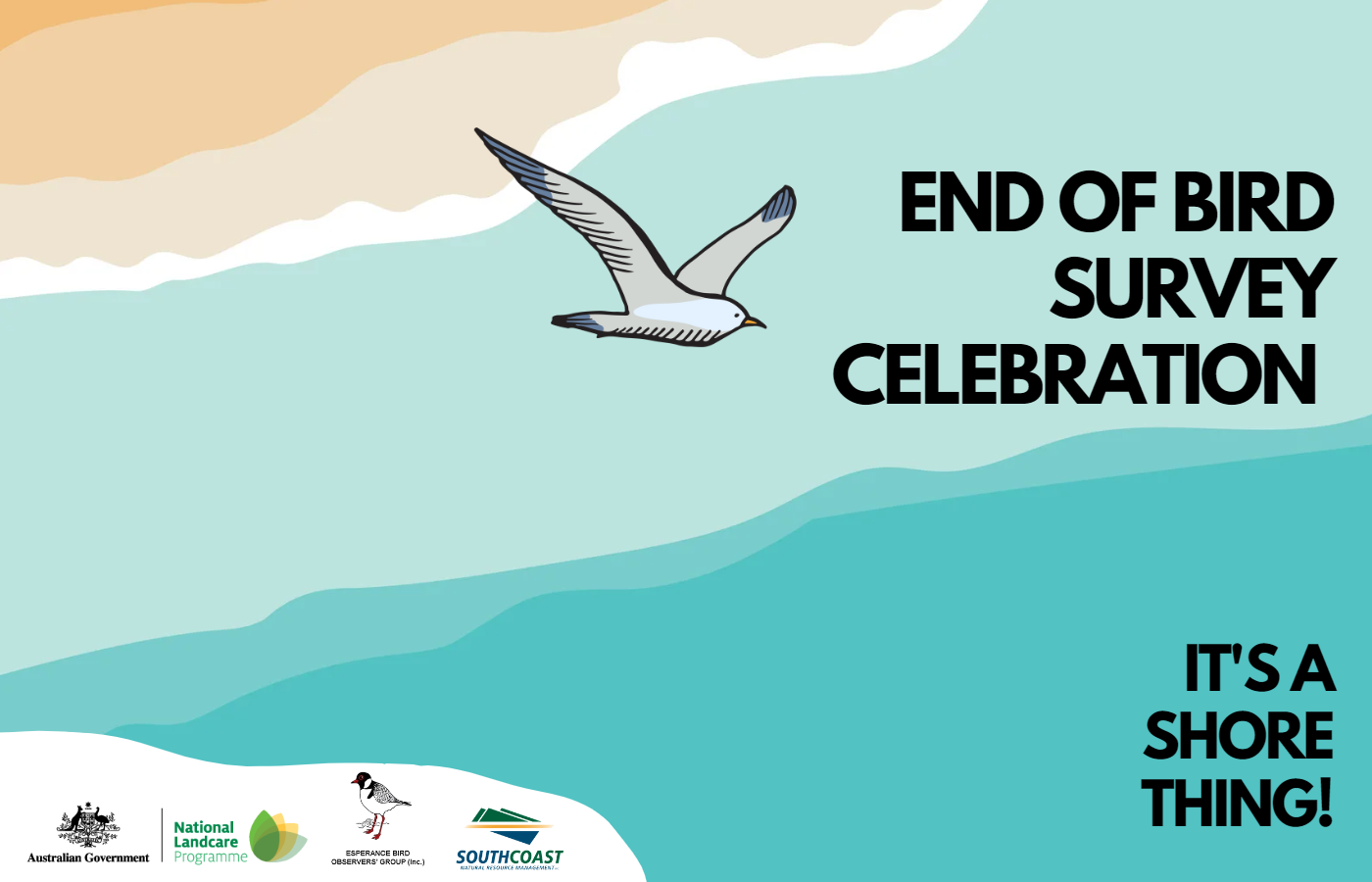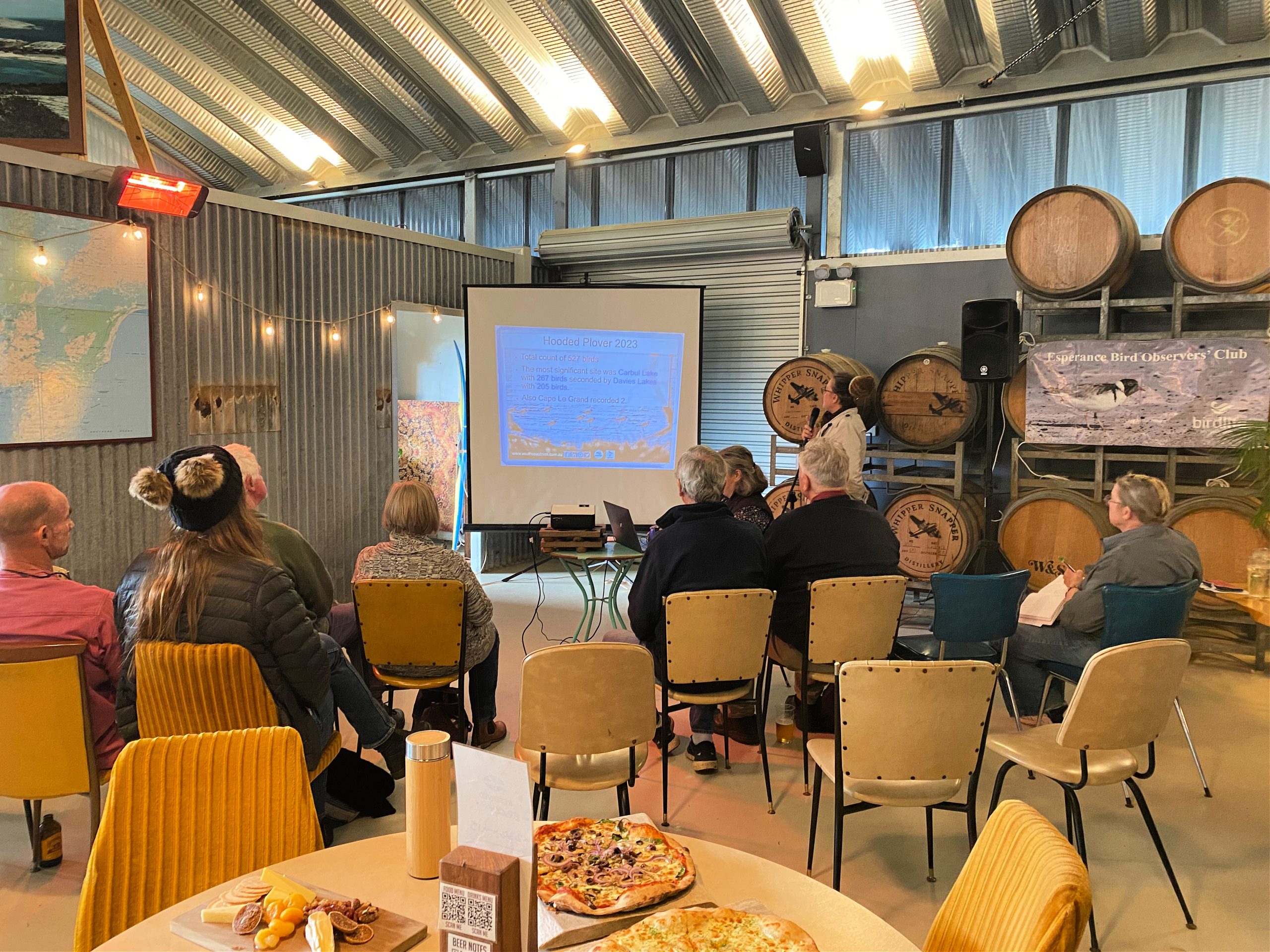From the desk of Dorothy, Project Officer Communications.
A small but enthusiastic group of Esperance bird enthusiasts flocked to the Lucky Bay Brewery on May 13th to celebrate the completion of this year’s BirdLife Australia Shorebird Survey. The “It’s a Shore Thing! End of Survey Celebration” gave birders the chance to debrief and get a preliminary peek at this year’s results.
Ramsar Wetlands Project Officer Claudia Magana said survey data was collected in February 2023 by volunteers during a survey coordinated by the Esperance Bird Observer’s Group (EBOG), with assistance from South Coast NRM. “The event was held to present all the data collected from 2023 shorebird/waterbird surveys to the volunteers, most of whom were from EBOG,” Claudia said.
“We could compare results from previous summer surveys and also review Adrian Pinder’s Report, which is currently only in draft form, but soon to be published”.

The event also allowed survey participants to celebrate the wonderful efforts of all involved and reflect on what could be done better during future surveys.
During the celebratory get together, EBOG member Elodie Goldsmith presented data collected for the Esperance region, which included inland lakes and coastal areas and Adrian Pinder’s data for the Lake Warden system and Lake Gore-Quallilup system. Claudia noted that while data was not finalised, trends indicated bird numbers were up when compared with the average over the last three years. Especially encouraging were the sightings of Hooded Plovers, the tiny birds that have a special place in the hearts of Esperance bird watchers on account of their tenacity and scarcity.
“We have had the highest count of Hooded Plovers in the last five years, with 527 birds counted on local lakes during the survey,” Claudia said. With the numbers in, and analysis of data underway, those attending the gathering had good cause to celebrate their part in helping provide the information that will help scientists advise policy and give shorebirds a chance to flourish.”
The most outstanding site for bird numbers this year for February was Bannitup Lake with a total count of 24 species and 7,375 birds compared to Lake Warden with 12 species and 4,364 birds. Species that had the highest numbers were the Black Swan with 5,793 and up from 2022 numbers of 2,848. Australian Shelduck numbered 3,968, down from the previous year of 6,879. “It was a relief to see higher numbers for Sanderling, with 450 counted: up from the 2022 count of 105, but Red-necked stint numbers were down at 862 compared to last year’s count of 1,933,” Claudia said.
Data collected will allow scientists and conservationists to track how well the wetlands are providing habitat for a range of birds. With consideration of weather, other climate and surface water monitoring data it can paint a picture of the health of a wetland. In turn, it can help determine what short or long term on ground actions are needed to continue to sustain a healthy wetland or improve it.
This year’s EBOG data will be collected and entered into Birdata App, a tool developed by Birdlife Australia to collect data collaboratively and scientifically as part of its efforts to monitor and protect Australia’s Birds. EBOG is keen to continue to support the program and rally volunteers to do all the 31 sites, including the Ramsar Lake Warden and Lake Gore wetlands in 2024, despite the uncertainty of funding.
“For now it’s on their calendar,” Claudia said.

The event also allowed survey participants to celebrate the wonderful efforts of all involved and reflect on what could be done better during future surveys.
During the celebratory get together, EBOG member Elodie Goldsmith presented data collected for the Esperance region, which included inland lakes and coastal areas and Adrian Pinder’s data for the Lake Warden system and Lake Gore-Quallilup system. Claudia noted that while data was not finalised, trends indicated bird numbers were up when compared with the average over the last three years. Especially encouraging were the sightings of Hooded Plovers, the tiny birds that have a special place in the hearts of Esperance bird watchers on account of their tenacity and scarcity.
“We have had the highest count of Hooded Plovers in the last five years, with 527 birds counted on local lakes during the survey,” Claudia said. With the numbers in, and analysis of data underway, those attending the gathering had good cause to celebrate their part in helping provide the information that will help scientists advise policy and give shorebirds a chance to flourish.”
The most outstanding site for bird numbers this year for February was Bannitup Lake with a total count of 24 species and 7,375 birds compared to Lake Warden with 12 species and 4,364 birds. Species that had the highest numbers were the Black Swan with 5,793 and up from 2022 numbers of 2,848. Australian Shelduck numbered 3,968, down from the previous year of 6,879. “It was a relief to see higher numbers for Sanderling, with 450 counted: up from the 2022 count of 105, but Red-necked stint numbers were down at 862 compared to last year’s count of 1,933,” Claudia said.
Data collected will allow scientists and conservationists to track how well the wetlands are providing habitat for a range of birds. With consideration of weather, other climate and surface water monitoring data it can paint a picture of the health of a wetland. In turn, it can help determine what short or long term on ground actions are needed to continue to sustain a healthy wetland or improve it.
This year’s EBOG data will be collected and entered into Birdata App, a tool developed by Birdlife Australia to collect data collaboratively and scientifically as part of its efforts to monitor and protect Australia’s Birds. EBOG is keen to continue to support the program and rally volunteers to do all the 31 sites, including the Ramsar Lake Warden and Lake Gore wetlands in 2024, despite the uncertainty of funding.
“For now it’s on their calendar,” Claudia said.
The annual ‘It’s a Shore Thing’ shorebird/ waterbird survey is a great example of citizen science. Citizens can collect the data and share it with the wider community. It’s a way we can connect with a place to learn about the wildlife that lives in such beautiful locations, places that we otherwise would drive by without being aware of the diversity and wonder of the critters that live there. These projects are important because without them we would never know if we needed to act to save a place, or if what we are currently doing is making a difference. Every little bit helps to maintain healthy environments.
While the survey work may, at times, be physically challenging, it is an enjoyable task, and that is why volunteers return to the field, mobile phones, binoculars and cameras in hand. “It’s great fun. Like a detective you are constantly trying to get your eyes tuned into the details to help you identify these shorebirds that look very alike at a quick glance,” Claudia said. “But once you look carefully you start seeing the difference – and not just in plumage but behaviours,” she said. It is the quirks of the various species that enable identification. “Some birds run and stop suddenly, or peck like a sewing machine as they walk feeding along a shoreline.”
The skills that enabled identification were honed with practice, and for that reason it is a good thing that people tend to get addicted to birdwatching: returning and experienced volunteers are especially welcome as they are able to take the lead in survey outings, helping to train those birders with less experience so that they can help in the quest to protect the birds of our shorelines.
If you would like to be involved in the 2024 Shorebird Survey in Esperance, get in touch with Claudia (e) claudiam@southcoastnrm.com.au
